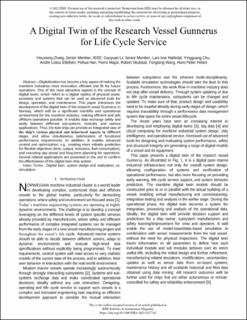A Digital Twin of the Research Vessel Gunnerus for Lifecycle Services: Outlining Key Technologies
| dc.contributor.author | Zhang, Houxiang | |
| dc.contributor.author | Li, Guoyuan | |
| dc.contributor.author | Hatledal, Lars Ivar | |
| dc.contributor.author | Chu, Yingguang | |
| dc.contributor.author | Ellefsen, André Listou | |
| dc.contributor.author | Han, Peihua | |
| dc.contributor.author | Major, Pierre Yann | |
| dc.contributor.author | Skulstad, Robert | |
| dc.contributor.author | Wang, Tongtong | |
| dc.contributor.author | Hildre, Hans Petter | |
| dc.date.accessioned | 2023-03-01T15:41:57Z | |
| dc.date.available | 2023-03-01T15:41:57Z | |
| dc.date.created | 2022-12-06T14:22:26Z | |
| dc.date.issued | 2022 | |
| dc.identifier.citation | IEEE robotics & automation magazine. 2022, 2-15. | en_US |
| dc.identifier.issn | 1070-9932 | |
| dc.identifier.uri | https://hdl.handle.net/11250/3055111 | |
| dc.description.abstract | Digitalization has become a key aspect of making maritime industries more innovative, efficient, and fit for future operations. One of the most attractive aspects is the concept of digital twins , which refers to digital replicas of physical assets, processes, and systems that can be used as advanced tools for design, operation, and maintenance. This article introduces the development of the digital twin of the research vessel (RV) Gunnerus in Norway, which will be a significant scientific and operational achievement for the maritime industry, making efficient and safe offshore operations possible. It enables data exchange safely and easily among different subsystems, modules, and various applications. Thus, the twin ship can provide an integrated view of the ship’s various physical and behavioral aspects in different stages and allow simultaneous optimization of functional performance requirements. In addition, it enables advanced control and optimization, e.g., creating more reliable prediction for flexible objectives (time, output, emissions, fuel consumption), and executing day-ahead and long-term planning for operations. Several related applications are presented in the end to confirm the effectiveness of the digital twin ship system. | en_US |
| dc.language.iso | eng | en_US |
| dc.publisher | IEEE | en_US |
| dc.title | A Digital Twin of the Research Vessel Gunnerus for Lifecycle Services: Outlining Key Technologies | en_US |
| dc.type | Peer reviewed | en_US |
| dc.type | Journal article | en_US |
| dc.description.version | acceptedVersion | en_US |
| dc.source.journal | IEEE robotics & automation magazine | en_US |
| dc.identifier.doi | 10.1109/MRA.2022.3217745 | |
| dc.identifier.cristin | 2089487 | |
| dc.relation.project | Norges forskningsråd: 280703 | en_US |
| cristin.ispublished | true | |
| cristin.fulltext | postprint | |
| cristin.qualitycode | 1 |
